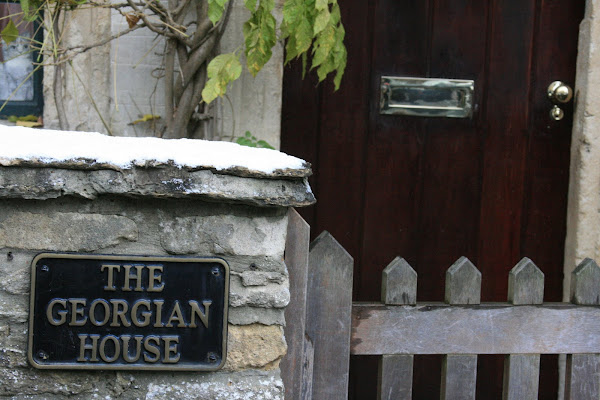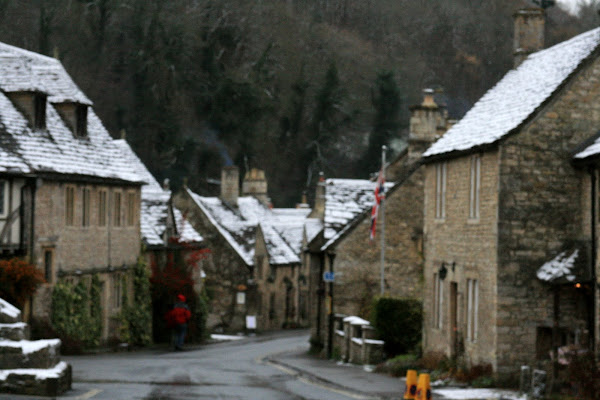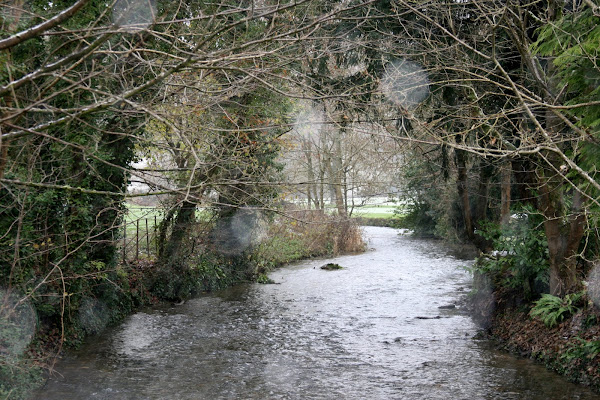After our recent trip to South America, our choice of a place to visit to mark the first anniversary fell on someplace quiet :). A little English village would be perfect..
And it was easy to find Castlecombe, the prettiest village in England in 1962 as most articles on the net described.
In the heart of Wiltshire and a little away from the city of Bath, The closest station to Castlecombe was Chippenham. With A journey time of little over an hour from Paddington, London we reached the Chippenham station a little past 3:00 PM. From there we were told the best place way to get to Castlecombe would be to take a Taxi. We got off from the taxi and walked a bit, only to find that we were at the end of the village.
Our stay for our little holiday was '
The Georgian House' owned by Lady Long, our delightful hostess.
It was a very cold day, colder than any we had seen so far that winter. So it was good to be indoors and we spent most of the evening talking to Long about the village and planning what we could do during our stay there.
 |
| Our Stay.. |
After Breakfast, we set out discovering the village. It has just begun to snow and the entire village truly looked frozen in time. It was cold , but lovely and we walked on.
The Market Square stands in the center of the village. When this structure was built is not known. The village website says it was in use around 1590 , when most of the villagers were involved in the clothe industry. The brook further down which we would pass by was the primary supply of water for industry.
As with the history of most places it is mostly the river which sustains life. and in this village it was this little brook which nurtured the woolen industry around the area. Things changed in the 17th century when the decrease in water levels saw weavers migrate to other places around Castlecombe.
 |
| The Market Place.. |
Though several houses have been rebuilt, Castlcombe still retains its distinct character.
It was lovely walking through the narrow streets, with the snow coming down..
Traces of brown still pepped through white sugar coated roof tops. The creeping cold was a constant reminder that there were warmer places like the village pub that we could head to. But we kept walking.
 |
| A view of the Village |
We passed the little brook and found that we were lost. A passerby gave us the secret to unlocking the door leading up to the manor hotel :). Tea at the hotel we decided.
 |
| On one of our walks.. |
The Manor hotel is one of the architecturally renowned buildings in Castlecombe and is as old as 1664. We were told that the house along with the manor was put on auction in 1947. We walk around the sprawling green surrounding the hotel , and cross the little bridge. We head into the hotel and treat ourselves to a welcome cup of steaming coffee. We walk past the hotel, and find that we are now behind St Andrew's Church.
 |
| The Manor Hotel.. |
A 13th century monument, the church is beautiful. Its amazing that there is so much history woven into the the relics here; A monument to Sir Walter de Dunstanville, Baron of Castle Combe, who died in 1270, and a clock believed to be one of the oldest working ones there is..
 |
| St Andrew's Church |
But what really caught my eye was the beautiful stained glass paintings along the windows of the church. The light filtering into this place of beautiful quiet made it all seem dreamlike.
 |
| Inside St Andrew's Church |
The first of our walks donw, we went down to the local pub for lunch, Large portions and beautifully flavored English food. The best Jacket Potatoes I've eaten so far. :)
 |
| Row of Houses. |
For the second of our walks, we decide it would be wise to ask for advise. Our hostess gives us a book and a map.. We think this should suffice. This time we are walking over the hills.
Before Castlecombe came to be an important center for the wollen industry, it was a British fort, tkaen over by the Romans and then the Normans.. The Normans built a fort , the remains of which we are told can be seen on the hill..
 |
| The Village Bridge.. |
We cross the village bridge again and head straight up. Theres a little brooke that seems to be traveling along with us. We take a small road on the side of the brooke as shown on the map and head up straight. A Wooden Gate seems to be the first indication that we are indeed on the right trail.
As we move along the frosted furrows , bits of the brown earth seem to peep through. We are careful as we walk along. Autumn is still stubbornly standing her ground and the red foliage against the backdrop of the fresh snow is amazing.
 |
| A walk through the wilderness |
 |
| Berries on Trees |
We reach the very top from where we can see the village church. its a beautiful sight. We can see the neatly spaces stone houses of the village from here. We now trek down and the road meets the motorway which leads us back to the Market place.
"The Woods are Lovely, Dark and Deep..
But I have promises to Keep
And miles to go before I sleep
And miles to go before I sleep.."
- Robert Frost
 |
| A view of the church from the hilltop |
We rest a while and then head out to have dinner . A beautiful two days, and we end on a celebratory note. S tried the Salmon , a recommendation by our hostess. We talk about how time seems to fly..Its been a year already :)
Down to the village pub after dinner and we already seem to know a lot of faces. Everybody seems friendly and as usual sport seems to be the conversation starter... A link across cultures :). This time it was Rugby scores.
 |
| The little celler inside the B&B where we stayed.. |
At Breakfast the next day, we talk to Lady Long. As always travel conversations span the length of the world. Lady Long told us about her time here and then we begin religon and religious beliefs. Theres a beautiful cellar in the house full of intresting relics of the Greek orthodox church. I am amazed.
I discover yet again that the need to relate to a higher power comes from an ingrained need for succor, to make meaning in an ever changing world. And the need not to strangely comes from the same..
I have for long now decided against the use of labels and so I stay non committal in my beliefs. The truth is not always black and white , but a somber shade of pretty Grey :).
Castlecombe has been truly wonderful and we shall come by to see her again.










